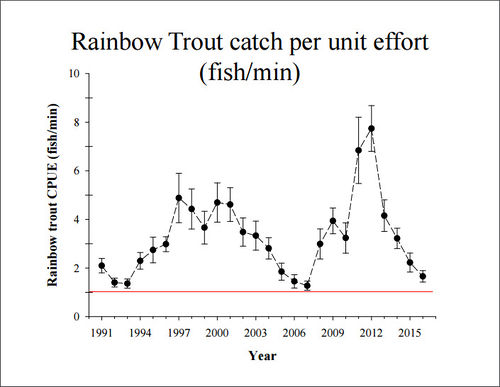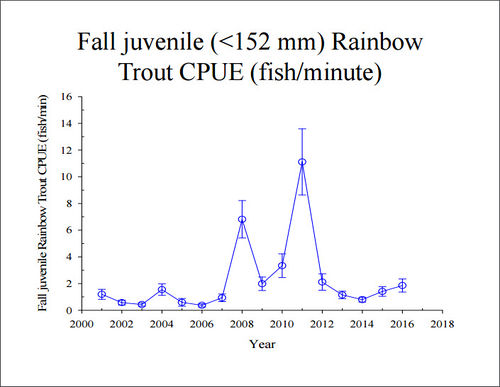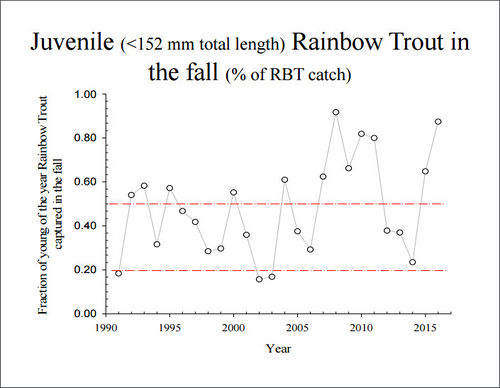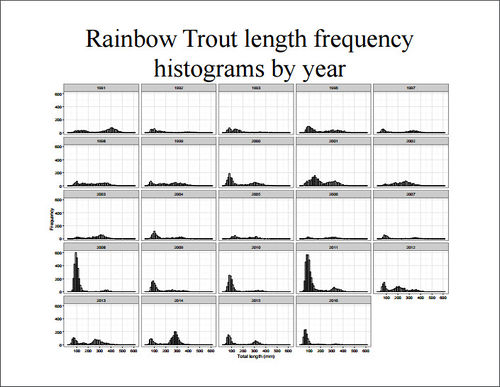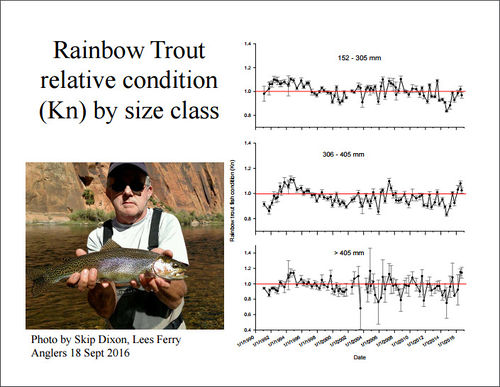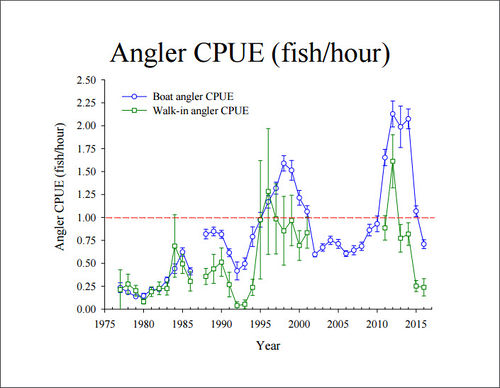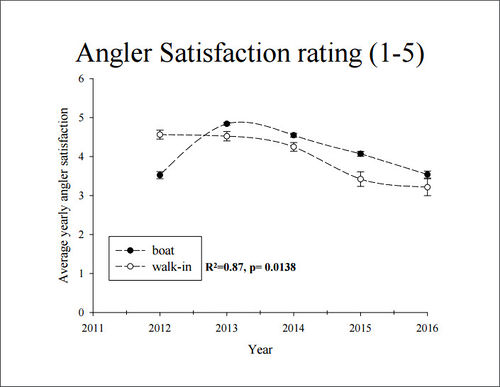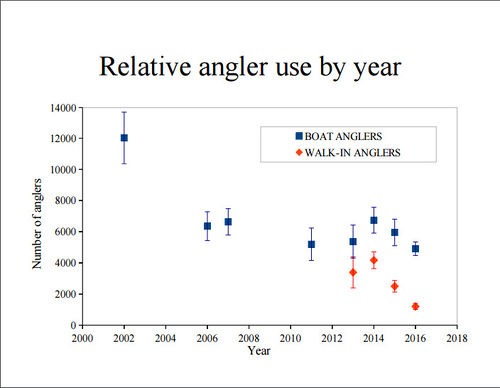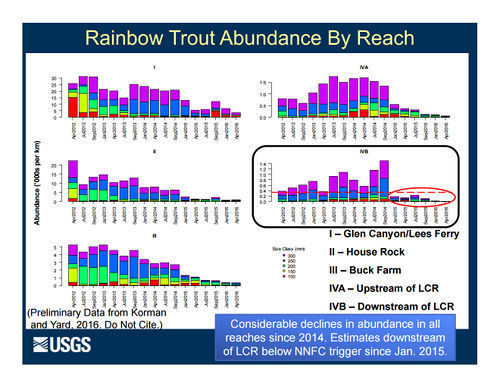Difference between revisions of "FISHERY"
Cellsworth (Talk | contribs) |
Cellsworth (Talk | contribs) |
||
| Line 63: | Line 63: | ||
[[File:RT_AnglerUse_2016.jpg |center|500px]] [https://www.usbr.gov/uc/rm/amp/twg/mtgs/17jan26/AR14_Rogowski.pdf] | [[File:RT_AnglerUse_2016.jpg |center|500px]] [https://www.usbr.gov/uc/rm/amp/twg/mtgs/17jan26/AR14_Rogowski.pdf] | ||
[[File:NO TroutAbundances2016.jpg|center|500px]] [http://www.usbr.gov/uc/rm/amp/amwg/mtgs/16aug24/Attach_07a.pdf] | [[File:NO TroutAbundances2016.jpg|center|500px]] [http://www.usbr.gov/uc/rm/amp/amwg/mtgs/16aug24/Attach_07a.pdf] | ||
| + | |||
| + | |- | ||
| + | ! <h2 style="margin:0; background:#cedff2; font-size:120%; font-weight:bold; border:1px solid #a3b0bf; text-align:left; color:#000; padding:0.2em 0.4em;"> 2014 Fishery Collapse </h2> | ||
| + | |- | ||
| + | |style="color:#000;"| | ||
| + | |||
| + | Data from a large-scale mark-recapture study was used in an open population model to determine the cause for long-term trends in growth and abundance of a Rainbow Trout Oncorhynchus mykiss population in the tailwater of Glen Canyon Dam, AZ. Reduced growth affected multiple life stages and processes causing negative feedbacks that regulated the abundance of the population, including: higher mortality of larger fish; lower rates of recruitment (young of year) in years when growth was reduced; and lower rates of sexual maturation the following year. High and steady flows during spring and summer of 2011 resulted in very large recruitment event. The population declined 10-fold by 2016 due a combination of lower recruitment and reduced survival of larger trout. Survival rates for trout ≥ 225 mm in 2014, 2015, and 2016 were 11%, 21%, and 22% lower than average survival rates between 2012 and 2013, respectively. Abundance at the end of the study would have been three- to five-fold higher had survival rates for larger trout remained at the elevated levels estimated for 2012 and 2013. Growth declined between 2012 and 2014 owing to reduced prey availability, which led to very poor fish condition by fall of 2014 (~0.9-0.95). Poor condition in turn resulted in low survival rates of larger fish during fall of 2014 and winter of 2015, which contributed to the population collapse. In Glen Canyon, large recruitment events driven by high flows can lead to increases in the population that cannot be sustained due to limitations in prey supply. In the absence of being able to regulate prey supply, flows which reduce the probability of large recruitment events can be used to avoid boom-and-bust population cycles. Our study demonstrates that mark-recapture is a very informative approach for understanding the dynamics of tailwater trout populations. [https://pubs.er.usgs.gov/publication/70187999] | ||
|} | |} | ||
Revision as of 13:04, 18 July 2018
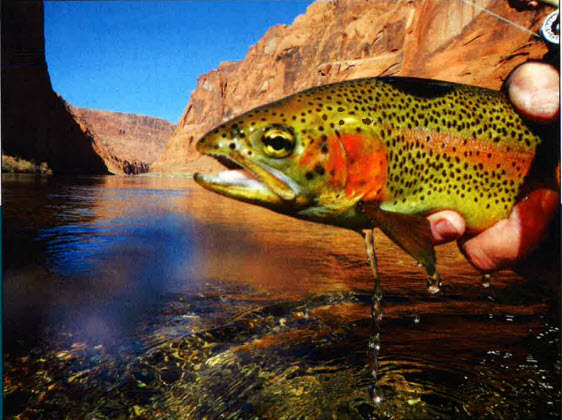 |
The Lees Ferry Rainbow Trout FisheryIn 1964, the Lees Ferry tailrace on the Colorado River was given birth by the completion of Glen Canyon Dam, which impounded Lake Powell. Subsequent water releases from the bottom of Lake Powell changed the once highly turbid, warm waters of the Colorado River into a constant cold (46-50°F), clear flowing river. Shortly after completion of the dam, the Arizona Game and Fish Department stocked rainbow trout (Oncorhynchus mykiss) in the 15-mile Lees Ferry reach and, in 1981, began to manage this section of river as a Blue Ribbon rainbow trout fishery. The trout began to flourish in the Lees Ferry reach from 1970-1985 when catches of rainbow trout above 10-pounds were not uncommon, and angler pressure was relatively low. In 1991, however, the Bureau of Reclamation implemented the Record of Decision flow regime, which consisted of higher minimum and more stable flows and allowed for increased trout reproduction and survival. Under these conditions, a huge population of trout developed causing individual fish growth rates to decline. Quite simply, there was a large number of fish competing for limited space and food items, resulting in a fishery where trout less than 14-in were dominant. In 2000, the Arizona Game and Fish Department began a long-term monitoring program sponsored by Grand Canyon Monitoring and Research Center to determine the effects of Glen Canyon Dam operation on the trout fishery at Lees Ferry and to make recommendations for improving this fishery. Since 2000, our data collection has shown an increase in the general health of all trout age classes (especially since 2002). This increase in fish health is usually associated with an increase in growth rates. There has been a marked increase in catch rates of young-of-the-year fish in recent years. With successful spawning and recruitment continuing to occur, fishing conditions in Lees Ferry are improving. [1] LTEMP Resource Goal for the Rainbow Trout FisheryAchieve a healthy high-quality recreational rainbow trout fishery in GCNRA and reduce or eliminate downstream trout migration consistent with NPS fish management and ESA compliance. Desired Future Condition for the Lees Ferry Trout FisheryA high quality trout fishery in GCNRA, as further described in the Recreation DFC that does not adversely affect the native aquatic community in GCNP. |
| Rainbow Trout | Brown Trout |
|---|
|
Visitor Use and Experience
HISTORY
Additional Links
|
